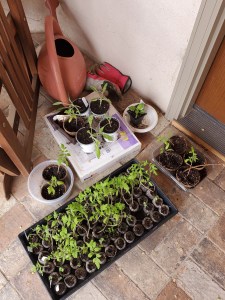Spring 2023 on the Horizon
Signs of Spring 2023
 It feels like winter will be here forever but spring 2023 is indeed on the horizon. Many signs are out today from the first crocus to the fact kids are on spring break. And we are climbing up the temperature gauge. So, the past few days I have focused on the gardens.
It feels like winter will be here forever but spring 2023 is indeed on the horizon. Many signs are out today from the first crocus to the fact kids are on spring break. And we are climbing up the temperature gauge. So, the past few days I have focused on the gardens.
New Fence
A new fence to discourage critters from roaming around my yard is now in place. It is not foolproof, but affordable and will act as a deterrent. However, it is really a temporary structure. The panels are held in place with steel stakes and a special attachment creates a handy gate. Everything can be easily moved. My hope is the local wildlife (and not so wild) will bypass my yard.
The Big Garden is now enclosed by two fences. While the outer fence could be jumped by either a deer or a large fox, multiple fences help deter the animals. It should encourage them to go on down the street to easier pickings.
Seed Starting
The very cool temperatures (and more to come-snow is in the forecast) have kept me from starting seeds which need warmer weather. However, my cool season crops have begun the hardening off process. Tomorrow may be difficult with highs only in the upper 30s but they will go outside for a short spell. Most have been transplanted to a larger container and are almost ready to go into the ground.
Spurred on by the blooming crocus, I have been amending the soil in the big garden with straw and mushroom compost. I went one step further today and planted peas, carrots and early beets. If we get a light covering of snow tomorrow the seeds will have both insulation and moisture.
My seed starting for Spring 2023 will turn to tomatoes, pepper and eggplants over the next several days. The bulbs finally popping up signal it is time. So, seed starting of all kinds will begin in earnest.
New Trees for Spring 2023
Two new trees were purchased yesterday. Both cherries. The North Star is a dwarf variety and can be hard to buy around here even though it is well suited to the climate and soil type. This tree was still dormant so it has been planted even though temperatures will be back down into the teens for the next few days.
The second tree is a Montmorency. I currently have one of these that has been growing for twenty-eight years. It is beginning to show its’ age. Since the buds are trying to leaf out on this replacement, the tree is in a protected spot on the back porch and will be planted once we get past the hard frosts. The stress of transplanting a tree trying to bud out accompanied by the big drop in temperature spells disaster. It is tough enough to get trees to grow on the windy and dry High Plains.
I like to plant trees. They are a sign of hope for the future. Usually, I only plant one a year. But the age of my current cherry tree is prompting me to plant two in Spring 2023. The winter moisture should give the trees a good start. Spring 2023 rains and snows are welcome. Soon more time will be spent outdoors. What do you plan to grow?


































